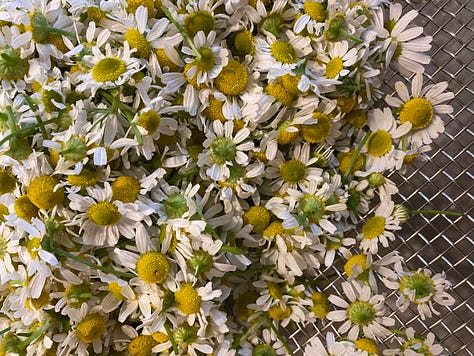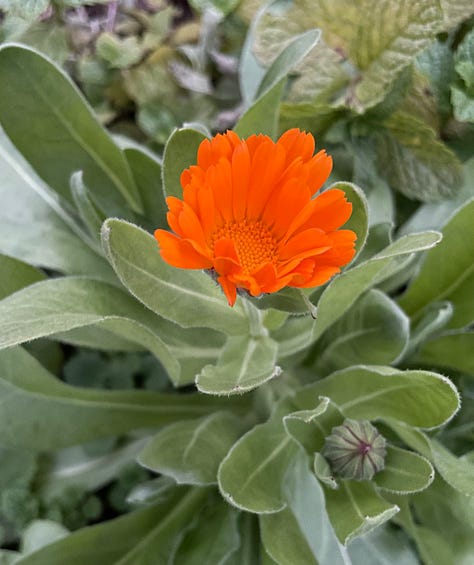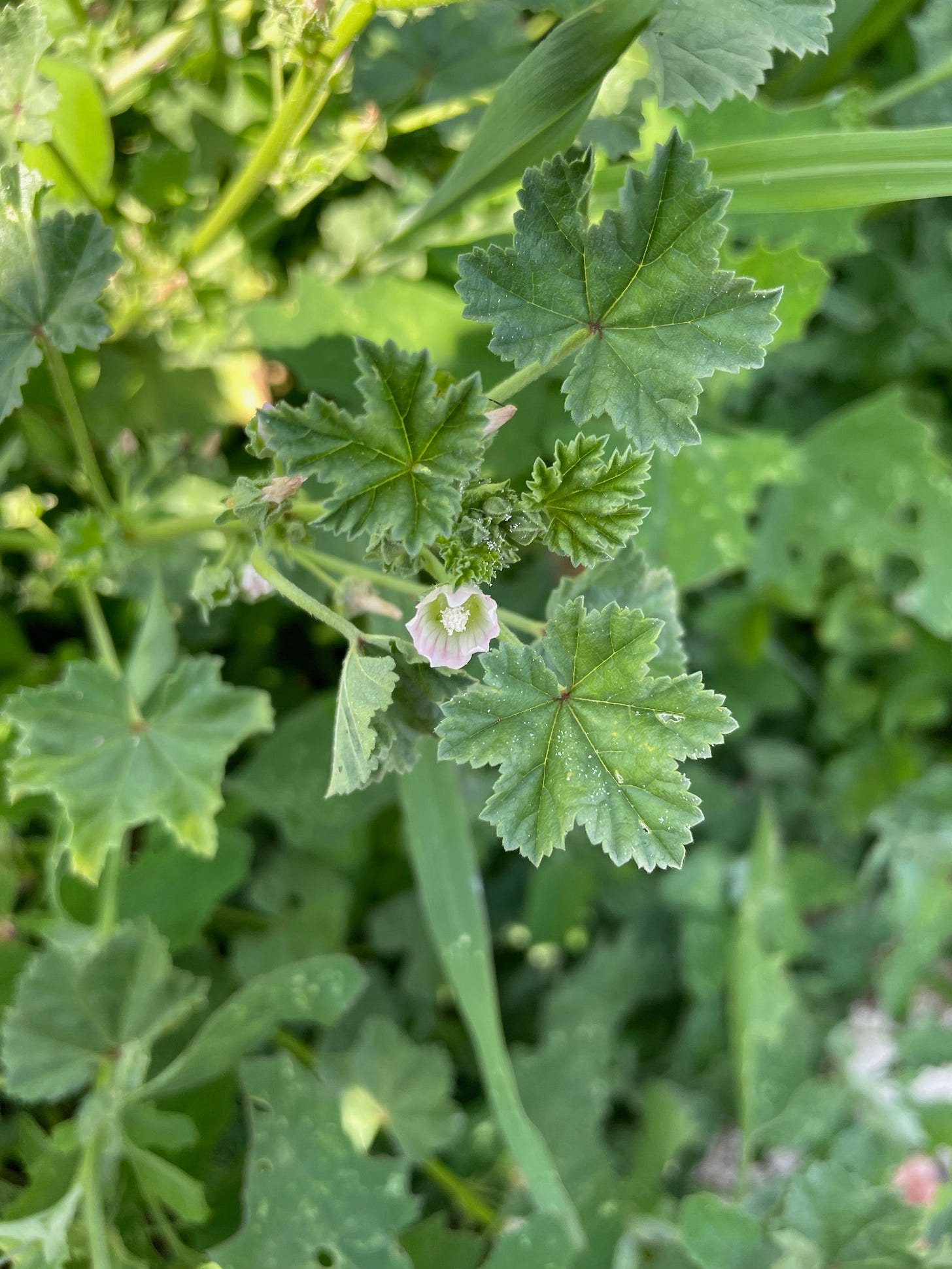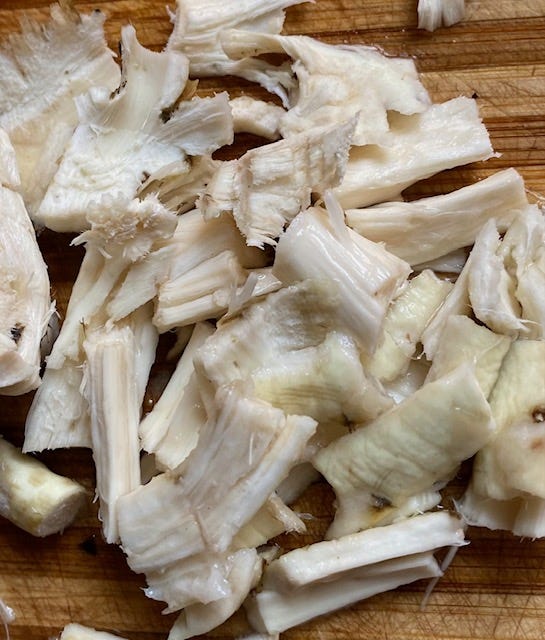When people are cocooning in winter, there's more time to think about food and cooking. Turning back to the mallow family for a fourth time, we have to add some recipes. One of the earliest posts at weedom celebrates the common mallow, Malva neglecta, which is found in any yard that isn't toxic with herbicides. The distribution of this plant is wide. and it has 40 or so close relatives circling the globe, allowing almost everyone to get their veggies. Be sure to also check out the marshmallow (Althea officinalis) and our Independence post featuring the related Hollyhock, (Alcea rosea).
Our pharmacognosy friends in the Middle East are traditionally big mallow eaters. They know that this weed is packed with vitamins and an array of essential minerals that the extensive roots transport up from the depths. In addition there is the cornucopia of anti inflammatory and antioxidant polyphenols and the slippery, demulcent carbohydrate polymers that soothe and protect mucous tissues of the gastrointestinal tract from end to end and throughout the body. This food is serious medicine. I believe that this weed is world-wide help for inflammation and injury to the GI tract, as well as external wound care.
Food
We'll start by spreading a very basic recipe from a site called Nutrizonia which presents Middle Eastern gastronomy. In Palestine this is called khobiza or Khobeizeh. Jordanians claim this recipe too.
Per 2 cups of coarsely chopped mallow leaves, you would also need a small onion sliced thinly, a half tablespoon of olive oil, and salt and pepper to taste. Start by sautéing the onions in the olive oil for 2-3 minutes, then add the chopped mallow leaves. Toss until those are hot and a bit wilted. Add the salt and pepper, and serve alongside a meat dish or lentils, etc. Lemon can be added for flavor, but the basic recipe doesn't require it.
The mallow leaves are very mild, so they pick up the flavor of whatever you cook with them. There's some sumac around the house at weedom these days, so that will go in the next time we sauté the yard greens. It's interesting to know that we have been cooking our own mix of greens with onions in a Palestinian manner. (Prayers that someday Palestinians will get a break from the historical cycles of conflict that have been going on for millenia in that region, usually resulting from external manipulations.)
In Greece they roll rice with some other flavorful ingredients up in grape leaves. They sprinkle olive oil on the rolls and steam them to produce dolmades. In Turkey, they do something veru similar which is called dolma. Sometimes larger mallow leaves are substituted for the grape leaves. More often the smaller leaves of mallow (ebegumeci) are used in a recipe with sautéd onions, tomatoes and lamb meat and spices.
Okra, a mallow relative is a delicious, nutritious, super slimy vegetable that adds thickness and body to soups. But this veg only grows in the warm weather. So you have to freeze or can it in order to have soup when you really want it. Or you can use mallow leaves in the cooler months for the boost of vitamins and minerals, as well as the thickening ability.
This easy mallow soup is made with
4 cups (~1 liter) of chicken or vegetable stock
2 cups (~500ml) of chopped mallow leaves
a large onion sliced finely
2 celery sticks chopped
a very large carrot chopped
clove of garlic crushed
1 potato sliced
optional 2 tablespoons (~30 ml) of plain yogurt or cream
a pinch of freshly grated or ground nutmeg
salt and freshly ground peppercorns to taste
butter for sautéing onions and carrots
Stir and cook the carrot pieces in butter for a few minutes, then add the celery and onions. Sauté until they are soft, but don't try to brown them. Add the 4 cups of stock and sliced potato and simmer until all the veggies are soft. Add the mallow leaves and simmer for another 5-10 min. Add the salt, pepper and nutmeg. Then either stick blend this mix, or transfer to a blender to puree it. After this, stir in the yogurt or cream, and warm the soup further if desired. Chives, parsley, rosemary, or whatever smells right can be sprinkled on top.
Throw mallow leaves into any of your favorite soup recipes if you want a little more body and green nutrition. If chopped well, blending isn't required.
Medicine
Sometimes soapmakers splash the oil and lye mixture during saponification. And sometimes we're so busy running with the mixing and molding that we don't notice it's gotten somewhere on skin that's uncovered. That's a problem that calls for the use of topical mallow. The easy way to obtain the demulcent qualities of mallow is by extracting the root into water. This is best done with fairly low heat or none to leave the mucilage intact. Soaking ground up roots in water overnight is an option, and using the resultant liquid as a topical spray or in a compress. Keep the liquid in the refrigerator if you want it to last for a few days. Bear in mind that the leaves and flowers also have the demulcent quality, plus a whole array of polyphenols and flavonoids. The roots of the common mallow, and marshmallow are both great sources of mucilage, with the latter being the easiest to harvest and chop up.
There are 2 ways to make a mallow root ointment: the slow cooker method, or soaking in oil at room temperature for a month or two. The latter is fairly difficult because mallow, being a salty root full of minerals, is a bit of a humectant, and draws in water. Ointment makers know what happens when there's too much moisture in an oil infusion. Microbial growth. So at weedom we like the low heat method. Heat is going to happen anyway when the oil is combined with beeswax or other components to make the ointment. Home made ointments are often made using 1 part beeswax to 8 parts oil, which imparts a consistency that will stay semisolid at room temperature.
The carbohydrate mucilage portion of mallow is not going to solubilize well into oil. More non-polar molecules are extracted into oils. To get the mucilaginous benefits of mallow, added to these non polar constituents, you want to make an aqueous decoction of the roots and stickblend that into a warm mallow ointment mixture in order to make lotion or cream. The home made lotions and creams should be kept cool, and refrigeration is a good idea to extend the life. These are quite variable in stability, depending on the plant matter used in the formulation, and what ingredients are used to stabilize the emulsion. Some herbs contain a good deal of antioxidant molecules such as rosemarinic acid or carnosic acid which confer a longer shelf life and protection from microbial growth. Another anti-oxidant option is to add some pure vitamin E oil.
Cosmetics manufacturers will tell you that beeswax is not an emulsifier, so that lotions made using beeswax will separate. And they’ll show you too. :-D This is true if you store the lotions in a warm place, or try to sell them at a sunny farmer’s market. You probably have seen bottles of emulsified salad dressings and sauces on store shelves which have separated into the water and oil layers. This is probably a result of faulty mixing, formulation, or transport at high temperatures.
Only a portion of the beeswax components have emulsifying properties, so it does not produce highly stable mixtures of oil and water that can be shipped on hot days. However we have made servicable lotions at weedom using approximately half and half oil and water mixture, with the oil fraction containing 12 to 15% beeswax. And the emulsions lasted well in a cool room or in the refrigerator. Often the plant materials infused into oil or into water contain some materials which assist in forming emulsions when mixed together. Some of these emulsions are quite difficult to crack, as we have found when attempting to extract plant substances in the lab.
Here’s a formula for a home made lotion which could be applied to minor wounds, scrapes, burns and bug bites, or even to diaper rash.
Use finely ground, or powdered dried herbs: 1 oz (~ 30ml) each of mallow, plantain, calendula and chamomile. Mix these and add to a cup (~240ml) of olive oil or avocado oil. Heat this using a double boiler arrangement with a pot or using a waterbath in a slow cooker, for about an hour.
While this is going on, infuse 1 oz (~30ml) each of those same 4 herbs into a cup of warm but not hot water. This infusion will quickly assume room temperature. The lower temperature allows the mucilage of the herbs to remain intact. You might choose to start the aqueous extraction the night before and let it proceed in the refrigerator after an hour or so. Strain this mixture with a cheesecloth and squeeze out the liquid.
Strain the warm oil infusion through a cheesecloth to remove the herb material. Form the cloth into a bag and squeeze out as much oil as you can. Measure the remaining liquid to determine how much beeswax and aqueous extract you will need. You’ll probably get about 6 oz of infused oil, and therefore use 3/4 oz of beeswax. 22 grams by weight is probably easier to measure. (The ratio is 1 part beeswax to 8 parts oil). Melt the infused oil and beeswax in a double boiler. Allow it cool a bit, but not so much that the beeswax begins to solidify, and add a few drops of pure vitamin E (tocopherol) oil. A few drops of lavender or other essential oil can be added for scent if desired. (Always highly dilute the essential oils for topical use to avoid skin irritation.)
An immersion blender, a.k.a. stick blender, is the ultimate tool for mixing the aqueous infusion with the oil infusion + beeswax. You can choose to place the stick blender in the oil, and add the aqueous infusion as you blend. The mix will turn opaque as the emulsion forms, and you should wind up with a reasonably thick lotion. Store the lotion in very clean ointment jars or jelly jars in a cool place or the refrigerator. Share some with friends, so that the product is used up within 2 or 3 months.



Lastly, is the lazy person’s topical compress: Dried mallow leaf or root, and plantain, calendula, and chamomile can be finely crumbled and mixed in equal parts. Fill single-use tea bags, or muslin bags with the mix. When you need a compress, you can dip the bag in an ounce of warm water to thoroughly wet the contents. Let it soak for a bit, then place the tea bag on whatever skin irritation, or burn or bug bite is in need of the anti-inflammatory, anti-microbial and demulcent properties of these herbs. Feel free to substitute with some herbs of your choice when particular properties are needed. Comfrey, violet leaves, or yarrow are some good candidates, as are plants from the mint family.
Welcome to the new subscribers to weedom. Everyone who has been here for a year or less, be sure to scroll back in the open archives of weedom to find posts about the other herbs mentioned here, as well as the mallow posts linked at the top.







Mallow roots are certainly tenacious, and so gratifying when the whole thing comes loose; more often than not, they simply break off at the crown and live to thumb their noses at us again. Come spring, I'll see if I can shield a patch from the dogs and give it a taste. Thank you.